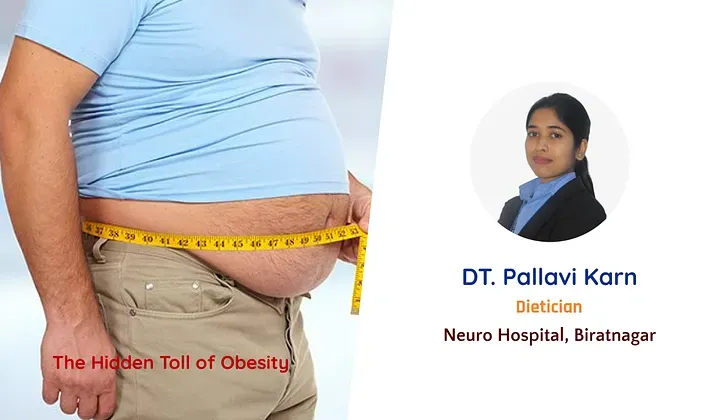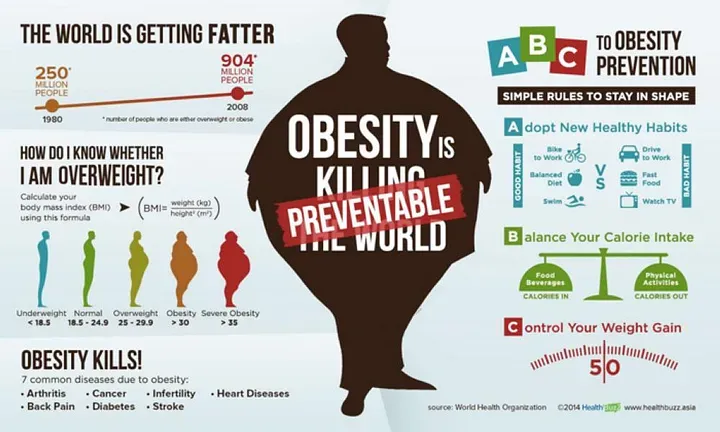Mind and Body: The Hidden Toll of Obesity

“Body image”-in the current generation this term stands out as a highly debated and controversial, often hailed as the benchmark for beauty in the glamorous realm. It’s a hot topic among various age groups, with females taking center stage in discussions. Diverse societies hold different beauty standards, with some glorifying a fuller figure while others favor a more corpulent physique.
Amidst the strong opinions surrounding this term, the essence lies in ensuring people feel not only comfortable but also embraced in their distinctive body sizes. This imperative task involves striking a balance between celebrating individual uniqueness and understanding the significance of maintaining a healthy body weight.
Body weight can vary, falling into categories like underweight, normal, overweight, and obese. According to WHO, obesity is the term that is used for abnormal or excess fat accumulation in our body having Body Mass Index (BMI) over 30kg/m2.
There are different cut-off points of BMI given by WHO to classify nutritional status of people based on their height and weight. However, since Asian people have short stature and different fat distribution (i.e. visceral fat percentage more than the subcutaneous fat) low BMI cut-off for Asian descent is proposed and is practiced in different regions. Obesity is the double burden of malnutrition in the context of the world while it has caused a triple burden of malnutrition in Nepal.
Our body operates akin to a machine, with food serving as its fuel, requiring conversion into energy. When the food we consume isn’t converted into energy, it accumulates as excess fat, potentially leading to overweight or obesity. It’s vital to note that obesity isn’t solely a result of overeating and lack of exercise; genetic, hormonal, and environmental factors also play significant roles.

Therefore, poor eating habits aren’t the sole culprits behind excess fat accumulation. Despite this, it remains crucial for individuals to aim for their ideal body weight according to height, as recommended by the American Cancer Society, to proactively prevent potential complications in the future.
Obesity, functioning as a chronic ailment, significantly hampers individuals’ daily activities, leading to a range of physical and mental health complications. Physically, it contributes to conditions such as heart disease, diabetes, cancer, gallstones, liver problems, asthma, menstrual issues, sleep disturbances, and mental health issues like depression, anxiety, self-hatred, low self-esteem, and eating disorders.
The global burden of illness report in 2017 revealed that obesity has reached epidemic proportions, causing over 4 million deaths annually. Alarmingly, this issue extends to adolescents and children, with the prevalence of obesity in the 5–19 age group increasing more than fourfold from 1975 to 2016.
Family dynamics also play a role, with a child having one obese parent having a 50% chance of obesity, escalating to 80% with both parents being obese. In Nepal, the prevalence of obesity has surged by 21–29% from 2013–2019, and among reproductive-age females (15–49), it has increased fivefold from 1996–2016, underscoring the urgent need to address the escalating challenge of childhood obesity.
Having battled with being overweight myself a few years ago, I understand the relentless cravings and the struggle to adhere to a diet and exercise routine. The desire to fit into a favorite dress, the guilt of deviating from the plan, and the cycle of self-hatred after indulging in favorite foods were all too familiar. Through my own weight loss journey, I’ve learned that perseverance is key.
“If I Can, You Can Too” is my mantra. Even in moments of failure, it’s about moving forward and trying again. Stay focused, prioritize sleep, eat well, and exercise — that’s the simple formula for success!
Medical interventions such as oral medications and bariatric surgery are few alternatives for those with obese grade II or III, however lifestyle modifications consistently emerge as the preferred approach for effective weight management in the majority of cases.
In our society, numerous myths and trendy diets surround the quest for weight loss. Seeking dietary guidance from professionals, such as clinical dietitians, is crucial for effective weight management. It’s essential to emphasize that simply receiving a diet plan is not enough; individuals must commit to following it for optimal results. Restricting the intake of empty-calorie foods like sugary drinks, sweets, and ultra-processed items is paramount.
Caloric consumption should align with daily activity levels, drawing from different food groups such as whole grains, proteins such as meat, fish, eggs, nuts, oilseeds, beans and pulses; fruits, vegetables and dairy products, to maintain a balanced intake of micro and macro nutrients. Opting for less oily, spicy, and sugary foods is advisable.
However, the effectiveness of a diet plan is amplified when coupled with regular physical activity. Incorporating 45 minutes of moderate to vigorous physical activity 3–5 days a week becomes a vital component for comprehensive and sustainable weight management.
Obesity poses a silent threat that not only impacts physical well-being but also takes a toll on mental health. It goes beyond concerns about body image, often leading to tragic outcomes for individuals.
A poignant example is the recent loss of Brandi Mallory, a renowned social media influencer known for her weight loss journey, who passed away at the age of 40 in 2023. The autopsy report attributed her demise to complications arising from obesity. Brandi, weighing 385 pounds with a BMI of 53.7 kg/m2 and a diagnosis of pre-diabetes, sheds light on the severe health consequences of obesity.
This blog aims to explore the multifaceted landscape of obesity-related complications and propose solutions. Emphasizing self-love involves caring for our bodies in every aspect, curbing unnecessary growth that jeopardizes our health.
Amidst life’s exciting plans and challenges, indulging in delicious food is essential for uplifting our mood.
However, by gradually adopting healthier eating habits, we can reduce the stress on our bodies and contribute to creating a healthier living space within ourselves. Let’s embark on this journey of self-care, one positive food habit at a time, and strive to keep our bodies, the places we reside in, healthy and thriving.




